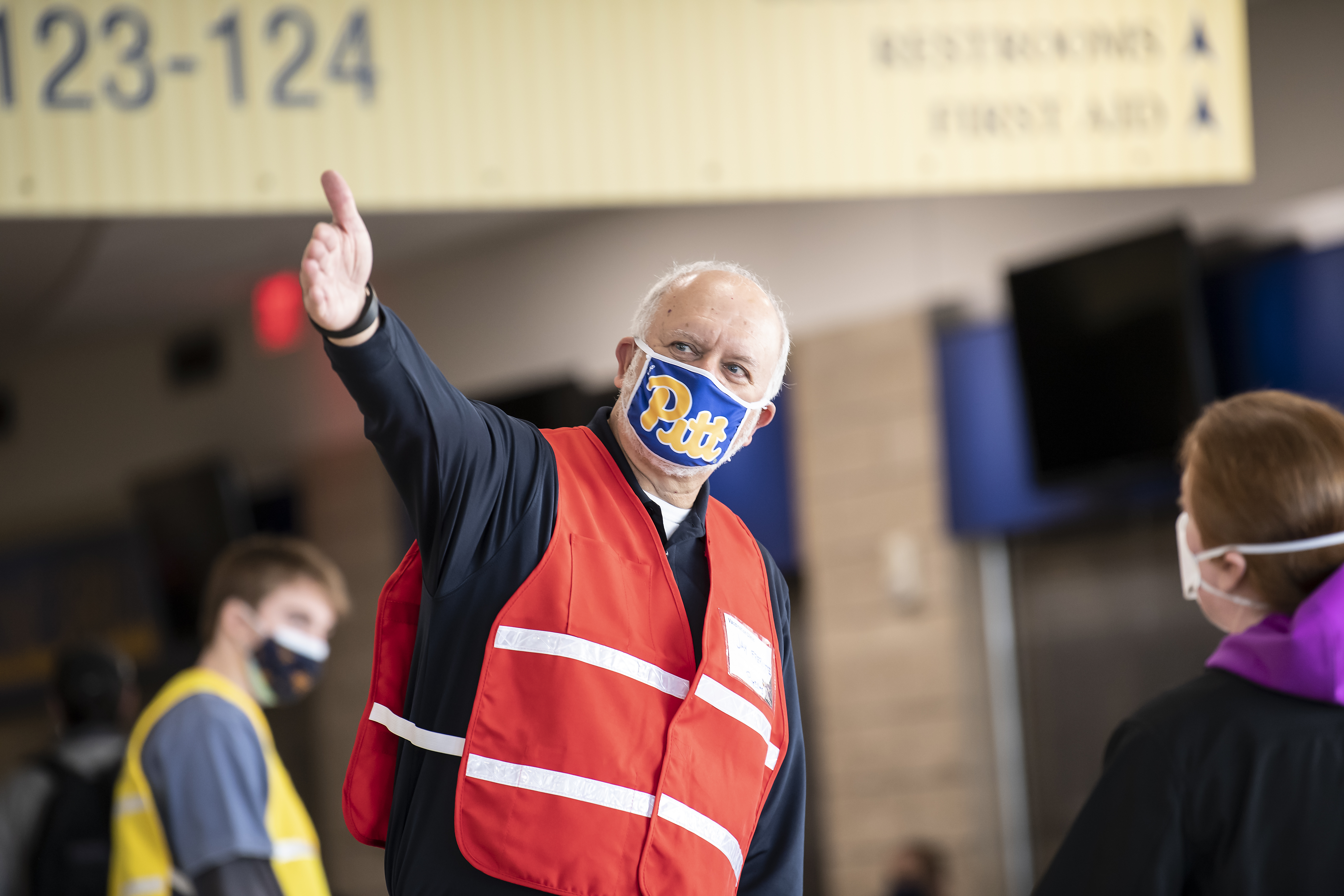Jay Frerotte led the department for more than 20 years and helped write the University’s pandemic plan.
By Anthony Conroy
In early 2020, before much of the world had heard about an emerging coronavirus, and much before the disease it causes had a name, the University of Pittsburgh already had a plan.
As the virus and the disease — now commonly recognized as COVID-19 — spread from country to country, then state to state, before finally landing on campuses in the U.S., Pitt began implementing guidance outlined nearly two decades earlier. In the years between, there were dress rehearsals: avian flu, H1N1 (swine flu), SARS, and MERS.
Each time a new virus threatened, the plan stayed fluid – always evolving, it was revised and strengthened, but never made so rigid that it left the University with no room to adjust. The response to each new threat became more efficient, the communication more seamless. By the time COVID became a household name in Pittsburgh, the city’s largest university was already grappling with the all-important question of in-person instruction, research, and work. For such unprecedented decisions, the accuracy of the information being fed to the administration was critical.
That effort required the ability to manage constant changes — changes necessitated by the speed in which the pandemic spread. It also required people to handle the pressure-cooker environment of adjusting to those changes while satisfying around-the-clock calls for information.
The seeds for Pitt’s planning began in 2007 when Jerome Cochran, the late Executive Vice Chancellor, turned to Environmental Health and Safety Director Jay Frerotte in 2007 and asked that he begin building the infrastructure for a University-wide pandemic plan. Years later, that and effort is one of the defining accomplishments of Frerotte’s career. Frerotte, 62, retired on January 31, capping a 21-year career at Pitt.
“I had people come up to me and say, ‘You mean we have a plan for something like this?!’” said Ted Fritz, the Vice Chancellor of Public Safety and Emergency Management and Frerotte’s most recent supervisor. “Of course, this was only an emergency plan and that plan had to be further developed, but it sure was nice knowing we had a starting point when COVID-19 hit America.”
JOINING PITT
Frerotte began his career in Baltimore, Md., as a sanitarian at the city’s health department. From there, he moved to The Johns Hopkins Hospital to be an environmental sanitarian and later added the roles of safety manager for the Hospital and The Johns Hopkins University.
“When I came here (in 2002), I had natural reservations because I had been a manager , but I wasn’t the EH&S director at Hopkins. So I wondered if I was cut out for it,” he said. “But I was from the Pittsburgh area, and I knew what to expect from the people. That proved true, because the people in Pittsburgh are authentic and care about honesty and hard work and doing things the right way. It was nice to come home.”
At the time, the hiring process was headed by Cochran and Paul Supowitz, then an associate general counsel in the Office of General Counsel. Looking back, Supowitz said they found the right person.
“Jay emerged in the recruitment process as someone with strong technical ability and experience, but also adept at working collaboratively and productively with the diverse constituencies and users at a large research university like Pitt,” said Supowitz, now the Special Assistant for Strategic Initiatives at the Office of the Chancellor. “These qualities are apparent in his long and successful tenure here.”
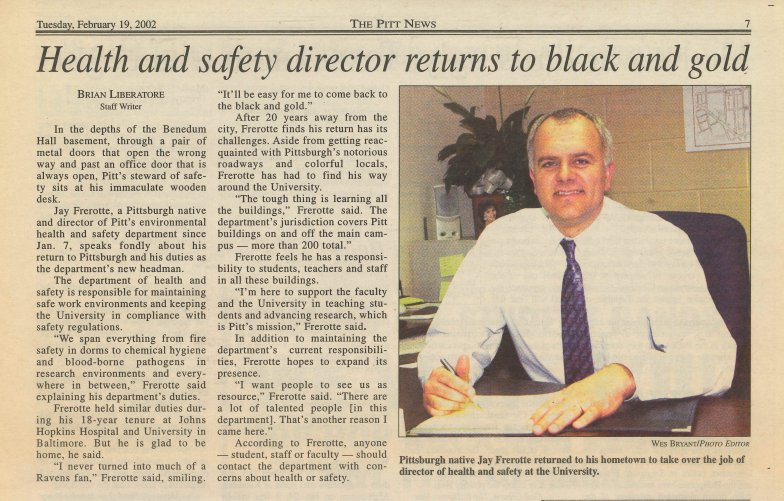
BIG CHALLENGES AWAIT
Since his arrival, Frerotte, once described by the Pitt Chronicle as having “a perfect combination of John Wayne confidence and Mr. Rogers sensitivity,” brought credibility and leadership to the role, taking over a department that he was told was “rigid” and “uncooperative.” Under his leadership, EH&S became a department now seen as collaborative, one whose work is welcomed and valued by its University partners.
Beyond battling those perceptions, Frerotte’s first major challenge at Pitt was overseeing EH&S’s role in the construction of the BST-3 building.
“When I first got here, [BST-3] was just a concept,” he said. “We also received the money for the Pitt Regional Biocontainment Lab. I, along with other Pitt people, went down to Washington (D.C.) to the National Institute of Health to start planning for that facility. To see that from concept to groundbreaking to completion, I learned a tremendous amount from that.”
Another challenge has been keeping up with his colleagues on the research side.
“Pitt was already a top-tier research institution when I got here, and we’ve just really fortified our position in research nationally. We worked really hard to the get the EH&S Department be a part of that. Safety’s really an active part of the research enterprise here. We lay eyes on all of the protocols and visit all the labs. But that didn’t just happen. It was a years-long process to get where safety is integrated in every safety application.”
After COVID-19 hit, no other issue would test Frerotte’s skills, the University resiliency, or the Office of Public Safety and Emergency Management, of which EH&S is a part, like the new emerging coronavirus.
‘LIKE THE WORLD HAS CHANGED’
When historians look back on COVID, they will remember the sniping over masking guidance, bed shortages, nursing home deaths, and grueling shifts worked by healthcare professionals around the world, but its effects impacted all walks of life. At the Public Safety Building, named after Jerome Cochran, on Forbes Avenue, Frerotte, Fritz and other members of the Emergency Command Committee worked to keep up with the pace of changing guidance and the necessity of information.
“[Fritz] was giving a daily update to the University leadership every night,” said Frerotte. “That was a big part of our day, where we’d say, ‘OK, what happened today?’ We’d write it all down, we’d update all these statistics, and then it would be released – never at a set time, because no two days were the same. It was a little news blast unto itself. Early on, that’s what it was. It was a growing network where people were feeding in data, such as how many students were calling Student Health Services who were sick.”
The University recorded its first confirmed case on March 21, 2020, after a student reported symptoms. It didn’t take long for the second.
“At the time, there were 371 cases in Pennsylvania, with most in Philadelphia,” said Frerotte. After Pitt’s first case was confirmed, “we had several calls about how we were going to control and investigate it. It was a Saturday. Then, at 6:30 that night, I got a call from [Pitt Police Deputy Chief] Holly Lamb that there was another case, a student taken from [a residence hall] to the UPMC Presbyterian hospital emergency department with symptoms.”
The second student had been traveling abroad before returning to campus, Frerotte said.
“So we went from having our first case to, by that night, having someone in the emergency department,” he said. “That kind of told us, ‘It’s here. It’s here in Pittsburgh. It’s on campus.’ That elevated things. It was like the world had changed.”
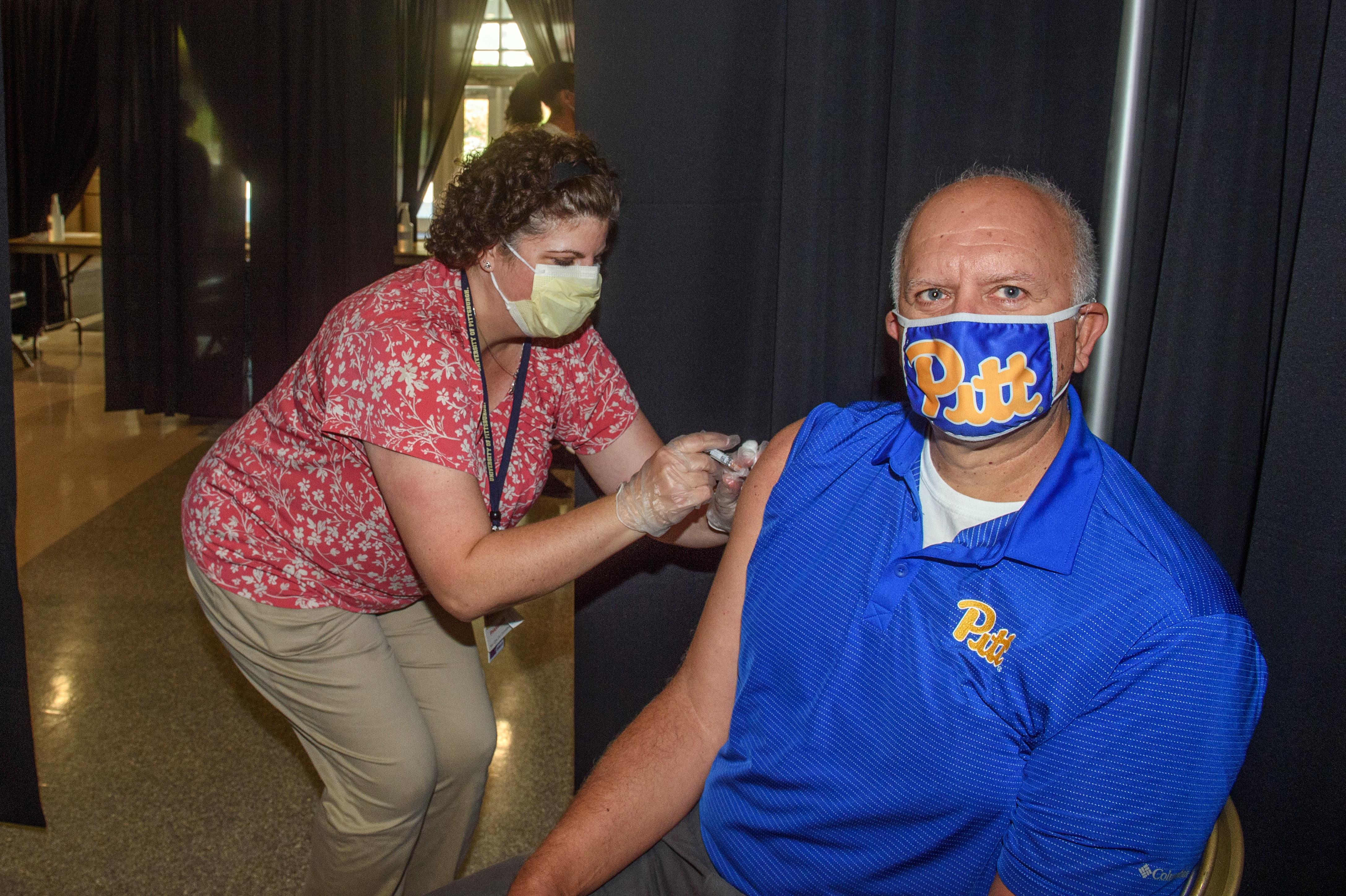
HOW TO PROCEED
The University next had to decide how to best manage operations. Chancellor Patrick Gallagher enlisted a number of people, including Frerotte, to help advise him on that call, and the decision couldn’t be made lightly, Frerotte said.
“The worst thing would be to be indecisive and then have a lot of sick students,” said Frerotte.
Another challenge was figuring out how to reopen the University to in-person classes and activities. When the students, faculty and staff returned to Oakland after of remote learning and working from home, Pitt resumed on-campus activities — but with a robust roster of new rules and restrictions in place.
“There was a lot of anxiety,” Frerotte said of the return to campus. “We’d get questions about social distancing and mask wearing. We were just trying to keep ahead of it. So, as the return began, I gave every department or school a liaison out of the EH&S office. Like a go-to person. The liaison from this office would walk through their space as they reopened it and advise on everything with the social distancing and with signage.”
Environmental Health and Safety Director Molly Stitt-Fischer, who will succeed Frerotte, praised her former boss. Frerotte’s “foresight” in the planning, she said, helped lay “the foundation for our response to a rapidly changing situation and allowed the University to have an effective management team in place before a pandemic was officially declared.”
Even more critical, she said, is that his “public health expertise and extensive knowledge of effectively delivering training, accurate information, and support for all the stakeholders required to maintain critical operations was, and remains, key to preserving the wellness of our entire community.”
As the University’s response to the pandemic transitioned from public safety to health professionals and medical doctors, there remained the polarizing issue of vaccinations and vaccination clinics. Frerotte’s role wasn’t finished.
FORGING PARTNERSHIPS
Dr. Margaret McDonald, the Associate Vice Chancellor for Academic and Global Affairs who sits on the Healthcare Advisory Group with Frerotte, said Frerotte’s 20 years at Pitt have been “invaluable,” as his institutional knowledge has been “a boon to every committee on which he sits.”
The list of committees and management teams that Frerotte sits on is impressive. In addition to the HCAG, which has recommended health standards and guidelines during the pandemic, here is a selection of groups that Frerotte currently sits: Environmental Health and Safety Committee (chair), Biohazards Committee, Chemical Hygiene Officers Committee, Regional Biocontainment Laboratory Coordination Committee, Recombinant DNA Committee and the Select Agent Security Committee.
Some of the previous committees Frerotte has chaired at Pitt provide an idea of how he helped orchestrate a COVID response that was so effective: H1N1 Influenza Task Force, Pandemic Preparedness Workgroup, and the SARS Task Force.
Inevitably, COVID arrived, but the work put in by people such as Frerotte helped lessen the impact. As Dr. Jaime R. Cerilli, Associate Vice Chancellor of Health Sciences, puts it, Frerotte’s assistance and efforts helped create “a new normal for the University.”
Dr. Cerilli, who worked closely with Frerotte on the BST-3 and RBL projects, said Frerotte spent “countless hours” in construction meetings and with the NIH regarding “security, chemical usage, select agent protocols and process improvement for operations and flow. …This is how I came to know and respect Jay as a person and as a professional. His management and leadership style inspire you to gladly help him in any way possible whenever he calls, because he is always – always – there to help you.”
Frerotte also established collaborative relationships between HCAG and the COVID Medical Response Office (CMRO) and was a central figure in establishing the Pandemic Safety Ambassador Network, Pitt CoVax program, and Concierge Stations.
Dr. John Williams, director of the CMRO and Chief of Pediatric Infectious Diseases at UPMC Children’s Hospital of Pittsburgh, said Frerotte brought “inexhaustible energy, unflappable calmness, and a persistent drive to get the job done. He made contributions to every aspect of our efforts.”
Frerotte was lauded for opening mass vaccination clinics — such as the ones held at the Petersen Events Center not long after the vaccinations became available. In addition to organizing the clinics, Frerotte distributed masks and personal protection equipment, and sourced freezers to hold the vaccines.
“Jay is the behind-the-scenes hero who was the connector to university resources that were needed to make those clinics possible,” said Dr. Melissa Somma McGivney, a professor and Associate Dean for Community Partnerships and a deputy director for the CMRO. “There was no job too big or too small for Jay to conquer — his goal was always to create the best experience for people coming to Pitt to be vaccinated,” she said.
Not long into the pandemic, in February 2020, the University was asked if it could handle off-campus mass vaccination clinics for two of Pittsburgh’s most vulnerable and underserved communities.
“Jay immediately stepped in to lead obtaining all the equipment needed to run a full-scale mass vaccination clinic at the Homewood YMCA and Hill District former Shop ‘n Save,” said Dr. McGivney. “He worked to design the layout of the vaccination process based on the (Petersen Events Center), secured tables, chairs, pipe and draping for the areas to make the flow as smooth as possible. He secured Pitt Movers and water and snacks from Pitt Eats to be brought to each site and connected with University Police for security and connections with Pittsburgh Police for support of the events.”
Added Dr. Williams: “He went above and beyond to make sure everyone had what they needed and did so with grace and kindness.”
Helping to organize clinics like the one in the Hill District was one of the most rewarding experiences Frerotte had at Pitt, he said.
“It was gratifying because it’s an underserved community in a lot of aspects,” he said. “The Pitt administration deserves a lot of credit for that – for, a) consenting to do that, and then b) providing the resources to make that happen. It’s Pitt giving back to the community in a huge way.”
While Frerotte is praised for his most recent achievements and work to keep the University safe during the COVID pandemic, it represents just a fraction of the body of work he’s performed during his 20-year career at Pitt.
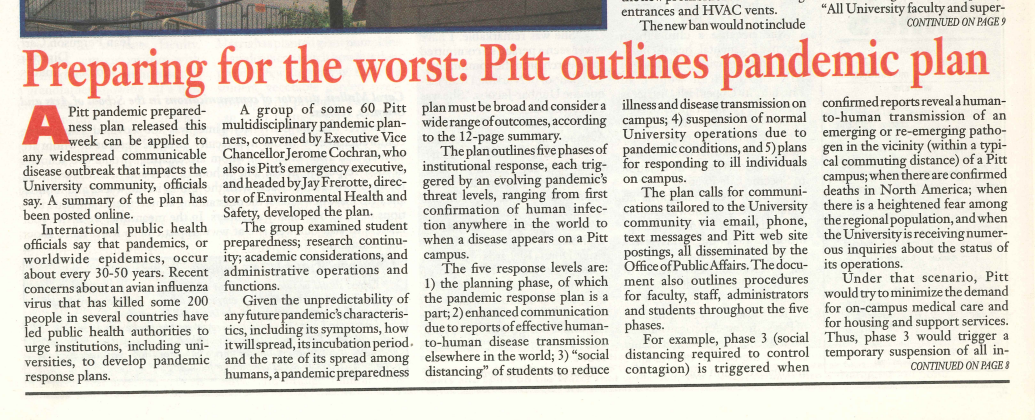
BUILDING A CREDIBLE PROGRAM
After arriving in Oakland, Frerotte was tasked with reinvigorating a department and hiring the most qualified people with expertise in workplace, chemical, biohazard, and animal safety. His establishment of new audit processes and knack at good hiring helped to boost Pitt’s safety credentials.
“I have always been impressed with Mr. Frerotte’s professionalism; knowledge about laboratory biosafety; and his ability to oversee and coordinate efforts to keep faculty, staff and trainees safe across the University,” said Dr. Lee Harrison, professor in the Infectious Disease Division and Director of the Center for Genomic Epidemiology at the Pitt School of Medicine. “Most importantly, Mr. Frerotte has always demonstrated extraordinary passion in his commitment to the health and wellbeing of the University community that goes well beyond his job responsibilities.”
While he worked to improve Pitt’s standards in the eyes of regulatory and accreditation bodies, Frerotte also identified shortcomings in employee health services. That led in March 2002 to a series of meetings with UPMC Work Partners/Employee Health Services to develop a proposal for services — services that would make up for coverage deficiencies for employees who Frerotte argued had unique workplace challenges.
A TEAM BUILDER
To change how his department was seen by University peers, he would require the help of the very people who were most skeptical — people who saw EH&S as being little more than an enforcement agency. To right the ship, Frerotte fostered new relationships with constituents across campus and nurtured relationships that were already in place. Soon, EH&S was viewed more as being “part of the team.”
He, and those he hired, brought a customer-service approach to how the department handled campus concerns — striking a friendlier, more approachable tone. In doing so, he made a department considered by some to be weak and ineffective into one of the most respected at Pitt. Frerotte’s willingness to work with others is not lost on his peers.
“In a separate endeavor, our internal Safety Committee decided to implement safety seminars for lab personnel,” said Dr. Patricia D. Kroboth, Dean of the School of Pharmacy. “The Committee Chair reached out to Jay who designated the appropriate staff from his area to work with our team. As a result, the inaugural seminar (in the summer was) only the first of many. We truly appreciate Jay’s willingness to customize training for us. He is a true team player.”
SAFETY FIRST
By all indications, Pitt is safer now than it was before Frerotte arrived. While there is an improved safety culture at the University and it’s hard to attribute whether one person has had a quantifiable impact on the entire Pitt campus, data shows the average number of injuries on campus have steadily decreased since 2006 and done so at a greater rate than the U.S. average.
According to the national Occupational Health and Safety Administration’s data for 2021, Pitt averaged 0.52 injuries in the workplace per every 100 workers, which is a record for Pitt. The average for other universities in the same period is 1.2 workers per 100 were hurt on the job.
“His leadership in the realm of safety is second to none,” said Fritz, who said he will miss talking about sports with Frerotte and “being able to bounce off of him some tricky and complicated issues.”
He added: “He was able to achieve a drastically lower rate of workplace injuries at Pitt; he was key in developing one of the largest, safest and finest regional biocontainment laboratories at any university in the country. Pitt is a highly respected research institution in part because of its exemplary safety record. Jay’s style is not dictatorial, but educational, and his superb staff has adopted it.”
Among them is Stitt-Fischer, named EH&S director in August, who Frerotte hired in 2010.
“Jay is an incredible mentor and has helped me along my journey from researcher to public health and biosafety professional, and now to Director of Pitt EH&S,” said Stitt-Fischer. “I met Jay when he graciously allowed me to volunteer with the Regional Biocontainment Laboratory management team to learn more about research safety for high containment laboratories. I continued to see Jay at national biosafety workshops and professional conferences during my fellowship with the National Biosafety and Biocontainment Training Program at the NIH, and I admired his thoughtful, logical approach to complex safety program management challenges. I was grateful to be able to return to Pitt as Biosafety Officer in 2010 and value Jay’s continued guidance and support.”
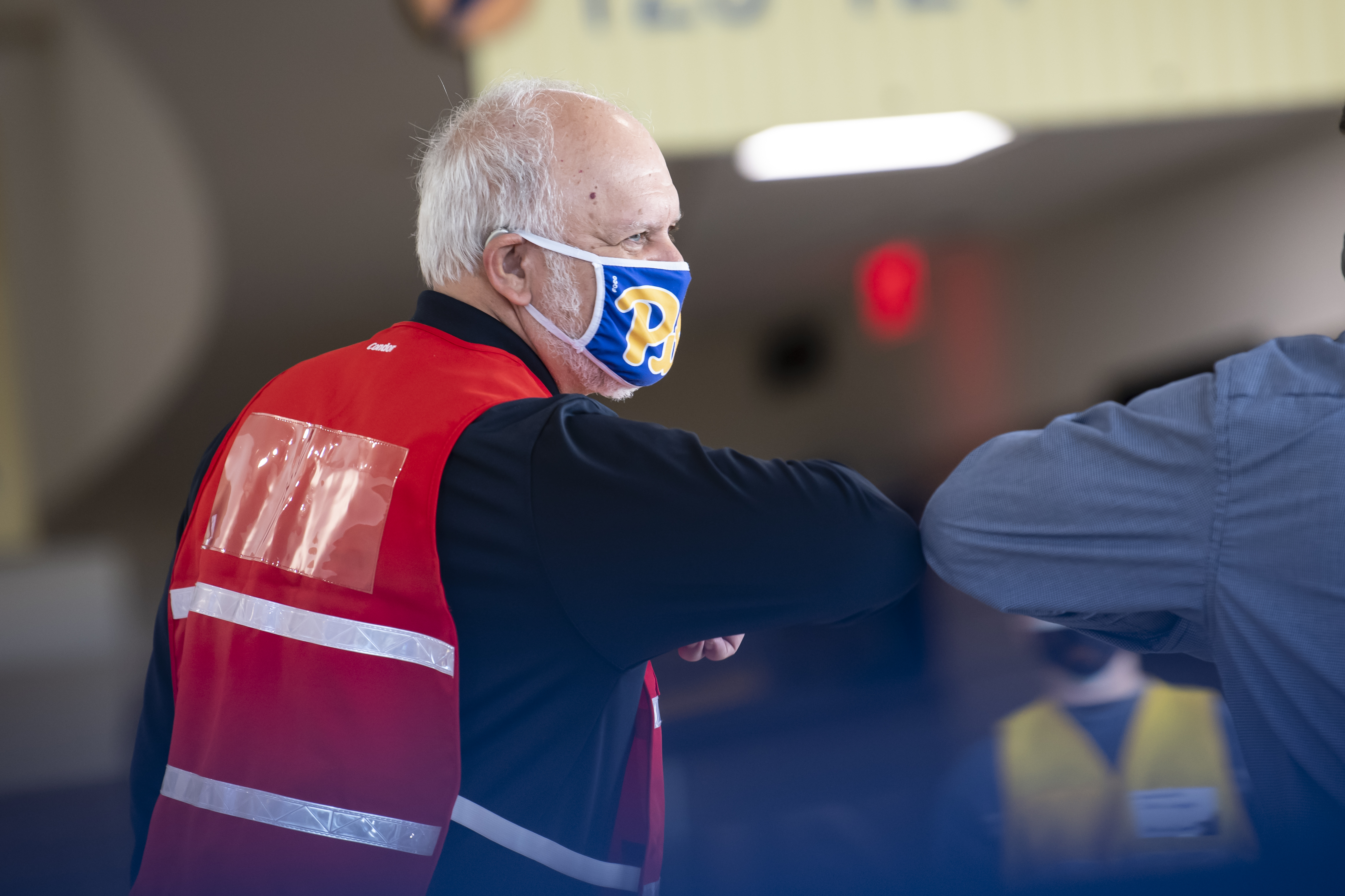
LOOKING AHEAD
Frerotte, who retires as the Assistant Vice Chancellor of EH&S, plans to spend more time playing golf and traveling with his wife of 38 years, Susan, also a Pitt retiree. The two will be heading south for the remainder of winter, going to warmer parts of the U.S. and visiting with their son and daughter, who are building their own families in Savannah, Ga. Each has a son, and a third grandson is on the way, Frerotte said.
Despite the traveling, Frerotte has no immediate plans to leave Pittsburgh – or Pitt – anytime soon.
“I just re-upped my Pitt season tickets for football,” he joked. When not watching Pitt sporting events and Pittsburgh Penguins games, he said, “I’m going to do the things I like to do. I always promised myself that I’d retire when I was eligible, and I’ve been lucky enough to do that.”
Before walking out the door, Frerotte praised his entire staff and noted the long hours they worked during the pandemic.
“My team is great,” said Frerotte. “I inherited good folks when I got here, and I’ve been fortunate to hire additional service-oriented professionals. They worked hard and stepped up. None of them had ever done things like contact tracing before, no one had encountered anything like COVID.
“It’s a foundational strength,” he added. “Pitt recruits world-class scientists, but if the science is not done safely, then you lose credibility. I give the leadership credit for recognizing the importance of that, and really supporting EH&S. And for our part, we try to recruit safety professionals with the right expertise, who have a thirst for knowledge and staying abreast of the best practices in a certain field of research. That is really important to EH&S’s mission and to Pitt’s mission. I have been fortunate to recruit many talented people that have wonderfully represented EH&S across every corner of the University.”
As he looks back on his career, Frerotte said the experience of helping write the University’s pandemic playbook represented “a culmination” of his life’s work, from the Baltimore Health Department to The Johns Hopkins Hospital to the University of Pittsburgh.
“I take some sense of pride in it because allowed me to use all the experiences that I had and apply them to the whole situation. So it really was a culmination of everything I’ve learned.”

